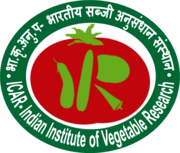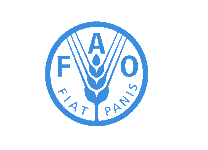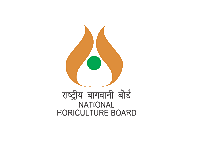-
भारत सरकारGOVERNMENT OF INDIA
-
कृषि और किसान कल्याण मंत्रालयMINISTRY OF AGRICULTURE AND FARMER'S WELFARE
DRBhardwaj

- Exploration, augmentation, and trait specific characterization of vegetable genetic resources
- Genetics, breeding and biotechnological interventions in cucurbits
- Development of varieties and hybrids in cucurbitaceous vegetables
- Creation of awareness and transfer of vegetable based technologies.
Conducted 36 explorations, augmented 2600 (seed vegetables); 168 vegetatively propagated (pointed gourd, spine gourd, sweet gourd & ivy gourd) accessions through ICAR-NBPGR/CAUs/SAUs/NGOs; deposited to NGB and sharing for research. Bitter gourd ‘gy-1’ (gynoecism) and pointed gourd ‘pt’ (seedlessness) new gene reported. Transchriptomes of gynoecious and monoecious bitter gourd 80 WRKY and 56 ARF useful factors for hybrid development, yield, and biotic/abiotic stress breeding. Bottle gourd resistant lineVRBG-12 for DM, VRBG-556 for gummy stem blight and bitter gourd NIC-122885 and VRBT-39 for DM and in pointed gourd VRPG-117, DR/AK-5, VRPG-07 and U-34/BP/DR/11 for RKN identified. In pointed gourd early stage sex determination through RAPD. De Novo transcriptome sequencing of bitter gourd using Illumine next-generation sequencer, from root flower buds, stem and leaf samples of gynoecious line (gy323) and monoecious line (DRAR1). A total of 65,540 transcripts for GY323 and 61,490 for DRAR-1 were obtained, identified 80 WRKY transcription factors. Parthenocarpic pointed gourd Stem gene(s) linked to the pubescence (sst), stem shape (rst), tendril coiling (stl), tendril branching (utl), and leaf pubescence (plf) are governed by a single gene which is first report and female sex associated RAPD marker obtained which is helpful in early assessment of gender in pointed gourd. In pointed gourd Maximum shoot proliferation of 6.2shoots per xplants with 100% shoot regeneration frequency was obtained from the female genotype on MS medium supplemented with 0.9 microMN6-BA and 200 mgl-1casein CH.
Methodologies Two lines of garden peas IIHR-611 and 663 showed high nodule intensity but the amount of acetylene reduction was less, suggesting the nodule intensity by itself may not indicate the nitrogen fixation. In bitter gourd 148 germplasm lines screened against Pseudoperonospora cubensis, NIC-12285 and VRBT-39 were moderately resistant with high degree of tolerance. In pointed gourd maximum loss (43%) occurred with the infection of root knot nematode (M. incognita) and the lines VRPG-117, DR/AK-5, VRPG-07 and U-34/BP/DR/11 were list infected with the nematode. Maximum seed yield was found 76.6 kg ha under bower system followed by Kniffin training system. Bower system gave 75.85 percent more seed yield than ground system. Novel Genetic Stocks Gynoecious’ bitter gourd GY-63’ (INGR-03037), ‘Parthenocarpic’ pointed gourd IIVRPG105’ (INGR-03035), ‘Tropical carrot (“IC570071,/fertile-CR-27F”) (INGR 10110), ‘Cluster bearing sponge gourd “VRSG-52 (INGR 10159), ‘Andromonoecious’ line of sponge gourd ‘VRSG-1’ (IC590826), Triple fruit bearing pointed gourd (VRPG15-11) and β-carotene/ chlorophyll rich bottle gourd (VRBG-14-08) developed and registered with NBPGR, N. Delhi. Varieties and hybrids
- Bottle gourd- Kashi Ganga, Kashi Bahar (Hybrid), Kashi Kiran, Kashi Kirti, Kashi Kundal
- Bitter gourd- Kashi Mayuri
- Pointed gourd- Kashi Alankar, Kashi Suphal; Kashi Amulya
- Sponge gourd- Kashi Divya, Kashi Jyoti, Kashi Saumya-hybrid
- Ridge gourd- Kashi Shivani
- Longmelon- VRSLM-16
- Dr. Rajendra Prasad Puraskar.2014. Indian Council of Agricultural Research, New Delhi
- Dr. Rajendra Prasad Puraskar.2014 Indian Council of Agricultural Research, New Delhi
- Young Scientist Associate Award.2014. Bioved Research Institute of Agril. & Technology, Allahabad (U.P.).
- Fellowship Award.2014. Hi-Tech Horticultural Society, Meerut (U.P.).
- Fellow Award of Horticultural Sciences.2014. Uttar Pradesh Academy of Agricultural Sciences, Lucknow (U.P.).
- Dr. B.R. Ambedkar Young Fellow Award.2009. Scientific & Applied Research Center, Meerut (U.P.)
- NAAS Fellowship.2020. National Academy of Agricultural Sciences, New Delhi.
- Fellowship Award of Horticulture.2016. Horticultural Society of India, N. Delhi
- Fellowship Award of ISVS.2014. Indian Society of Vegetable Science, Varanasi (U.P.)
- Fellowship Award of ISPGR 2013. Indian Society of Plant Genetic Resources, New Delhi
- Shukla, A., Singh, V.K., Bharadwaj, D.R., Kumar, R., Rai, A., Rai, A.K., Mugasimangalam, R., Parameswaran, S., Singh, M. and Naik, P.S.2015. De novo assembly of bitter gourd transcriptomes: gene expression and sequence variations in gynoecious and monoecious lines. PLOS ONE, 10(6): 1-19.
- Ram, D.‘*’, Kumar, S., Singh, M., Rai, M. and G., Kalloo.2006. Inheritance of gynoecism in bitter gourd (Momordica charantia L.). Journal of Heredity, 97 (3): 294-295.
- Rai, G.K., Singh, M., Rai, N.P., Bharadwaj, D.R. and Kumar, S. 2012. In vitro propagation of spine gourd (Momordica dioica Roxb.) and assessment of genetic fidelity of micro- propagated plants using RAPD. Physiology and Molecular Biology of Plants, 18(3): 273-280.
- Major Singh, Sanjeev Kumar, A.K. Singh, Ram, D. & G. Kalloo.2002. Female sex-associated RAPD marker in pointed gourd (Trichosanthes dioica Roxb.). Current Science, 82: 131-132.
- Bhardwaj, D.R. ‘*’, Gautam, K.K., Saha, S., Nagendran, K., Pandey, K.K., Singh, A.K., Singh, P.M. and Singh, B. 2018. Mining the sources of resistance for downy mildew and gummy stem blight in bottle gourd (Lagenaria siceraria L.). Indian Journal of Agricultural Sciences, 88(5): 746-750.
-
Published Books
- Bhardwaj, D.R. 2020. Vegetables: Genetic Wealth and Crop Improvement. ISBN 978-978-93-89719-46-8 Daya Publishing House: A Division of Astral International Pvt. Ltd. N. Delhi.
- Bhardwaj, D.R. 2018. Vegetable Genetic Resources: Principles and Management. ISBN:978-93-5124-970-2 Daya Publishing House: A Division of Astral International Pvt. Ltd. N. Delhi.












